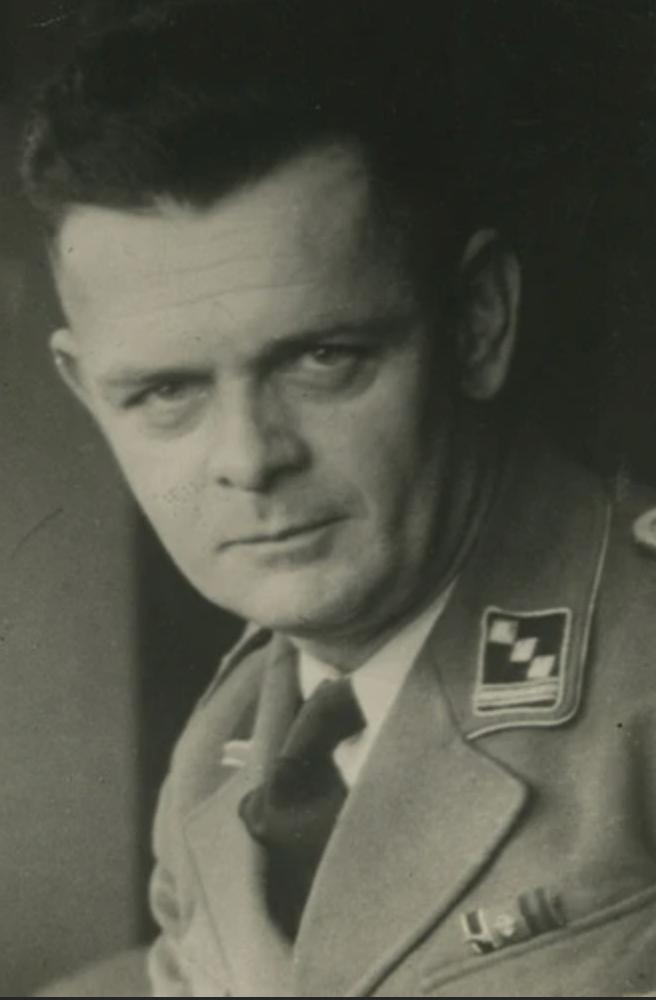Leeuwarden-Dokkum | Liberation route: section 6
On 14 April around 19:00, the villages of Akkerwoude and Murmerwoude (now merged into Damwâld) were liberated by the Royal Canadian Dragoons. No fighting was necessary. There was hardly any enemy to be found in this area.
Overjoyed residents threw their arms around the Canadians’ necks. There was an immense feeling of relief. However, the Dragoons had to move on quickly to Dokkum.
The next day, it became clear that the danger had not yet passed. As in other parts of Friesland, groups of German soldiers and their Dutch accomplices were on the move. Some tried to escape or even fight. Others planned to surrender as soon as they encountered Allied troops.
The NBS had set up an observati…
On 14 April around 19:00, the villages of Akkerwoude and Murmerwoude (now merged into Damwâld) were liberated by the Royal Canadian Dragoons. No fighting was necessary. There was hardly any enemy to be found in this area.
Overjoyed residents threw their arms around the Canadians’ necks. There was an immense feeling of relief. However, the Dragoons had to move on quickly to Dokkum.
The next day, it became clear that the danger had not yet passed. As in other parts of Friesland, groups of German soldiers and their Dutch accomplices were on the move. Some tried to escape or even fight. Others planned to surrender as soon as they encountered Allied troops.
The NBS had set up an observation post in the church tower in Murmerwoude. In the afternoon, a group of German soldiers and Dutch collaborators approached across the Achterwei from Rinsumageest. The resistance fighters decided to open fire on the group from the church. It appeared that a horse-drawn wagon had been loaded with ammunition, as it went up in the air with a huge bang.
Four German soldiers were killed instantly and a fifth was left severely wounded. Geert Gerding (51), a civilian from Peelo, was also killed. He was walking next to the wagon and had been forced to transport the ammunition for the soldiers.
In the chaos that followed, most of the group fled in the direction of Dokkum. Two Germans and the Dutch NSKK member (paramilitary and armed supply unit) Arie Notenboom, who cycled ahead of the group, were unable to escape. The Dragoons had also been notified in the meantime. After they opened fire from their vehicles, one of the Germans surrendered. Notenboom and the other German managed to escape again on their bicycles.
Harmen Brouwer (23) and Jan Kaper (23), both members of the NBS, tried to force the men to stop. But they immediately opened fire and killed both Brouwer and Kaper. Notenboom and his German companion eventually hid in a farm belonging to the Keulen family between Rinsumageast and Âldstjerk.
The NBS soon got wind of their whereabouts and enlisted the help of the Dragoons. Once the farm was surrounded, Notenboom came out. While Notenboom was disarmed, either he or the German threw a hand grenade at the NBS men. One of them, Bauke Lyklema (28), was seriously injured. He died the next day.
Notenboom was killed immediately after the incident. The German continued to hide in the farmhouse. The Dragoons took no more chances after this and set the farmhouse on fire. The German soldier died in the fire.
Harm Brouwer was a marine and known in De Westereen as a milkman. In De Westereen, a street was named after him. Jan Kaper was a marechaussee in Amsterdam. In that position, he had to arrest Jewish citizens against his will. He eventually went into hiding in Akkerwoude and joined the resistance there.
Bauke Lyklema was a municipal cleaner in Drachten. A plaque bearing his name hangs in the town hall in memory of his death.
Liberation Route Europe is a transnational memorial. A route that connects memorial sites and stories from all over Europe. For more information, visit www.liberationroute.com
Sights on this route
Starting point:
Waypoint walk 10
Leeuwarden
Navigate to starting point
Waypoint walk 10
Leeuwarden
Navigate to starting point
Fries Verzetsmuseum
Persoonlijke verhalen en natuurlijk alles over de overval op de Leeuwarder gevangenis, vind je in het Fries Verzetsmuseum. Bij de overval werden 51 verzetsstrijders bevrijd zonder een schot te lossen.
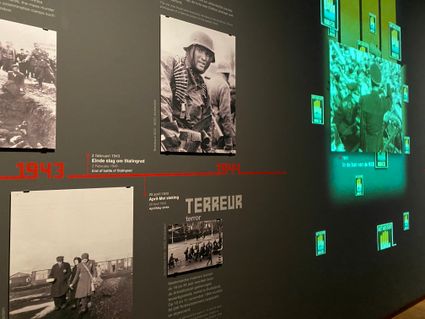
The liberation of Leeuwarden
On 11 April 1945, it became clear that German resistance in the north of the Netherlands was limited. On 12 April, the Allies seized this opportunity to advance on Friesland as quickly as possible. One of the main goals was to liberate Leeuwarden.
The liberation of Leeuwarden
On 11 April 1945, it became clear that German resistance in the north of the Netherlands was limited. On 12 April, the Allies seized this opportunity to advance on Friesland as quickly as possible. One of the main goals was to liberate Leeuwarden. The 9th Canadian Infantry Brigade was designated for this purpose. But things would turn out differently.
On 12 April, the Royal Canadian Dragoons entered Friesland at Noordwolde. They were to conduct reconnaissance with their armoured vehicles and reach the Wadden Sea as quickly as possible. As a result, the German troops in Friesland and Groningen would be separated.
On the night of 14 to 15 April, three Squadrons of the Dragoons were at Suameer. Burgum could not be reached earlier that day, because the bridge at Burgummerdam had been blown up by the Germans.
Meanwhile, all sorts of things were happening in nearby Leeuwarden. On 12 April, the airfield had been blown up by the Germans. And they left the city on 14 April. Leeuwarden would not be defended. The Burgerweeshuis (Civil Orphanage) that had housed several German agencies was set on fire. An attempt to blow up the telephone exchange failed due to an ingenious intervention by the resistance. In the early morning of 15 April, the resistance also took to the streets en masse to occupy important points and to capture Germans who had remained behind.
The Dragoons in Suameer were in contact with the resistance in Leeuwarden. Due to various reports, it was unclear whether there was now heavy fighting in Leeuwarden or whether the Germans had left the city completely. Because the Germans had blown up important bridges on the route from Heerenveen to Leeuwarden, the infantry could not quickly provide assistance.
So, the Dragoons went to take a look for themselves. Initially, a patrol of four vehicles was sent via the Groningerstraatweg into the city around half past eleven. One of the Canadians in those vehicles recorded the following:
"As we entered the city, passing through the concrete barrier by the narrow passageway left for normal traffic, we were met by an almost hysterical patrol of Resistance men [...] In a few moments the news of our arrival had spread through the city, and we were given a fantastic welcome as we rolled slowly forward into the centre of town."
A resident of Leeuwarden recalled:
"We lived close to the Groningerstraatweg, where our liberators passed. Many hundreds of us stood there, all happy spectators. All of a sudden, two ladies from the row flung themselves forward and threw their arms around the Canadians' necks, saying: "Oh darlings, you’re here at last!"
After the patrol determined that the coast was clear, the entire C Squadron, a detachment of the Royal Canadian Engineers and Regimental Headquarters of Lieutenant-Colonel Landell followed. Leeuwarden had been liberated. After this, thousands took to the streets. One of the Canadians wrote:
"We halted, and were immediately surrounded by laughing, yelling mobs of people, bringing flowers to give to us, and cheering every move. The Resistance men were everywhere, doing their best to keep the people within bounds and off the cars, but their efforts were hardly necessary. I never saw a more satisfying gathering in my life."
Leeuwarden had been liberated by the Dragoons through unexpected circumstances. On the night of 15 to 16 April, Canadian infantry moved into the city.
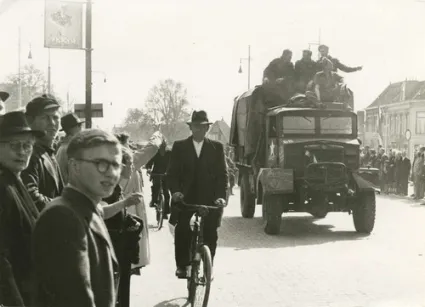
Seventy evacuees from Arnhem and Limburg
The grave monument in Gytsjerkwas erected in memory of Maria v/d Heuij. Maria was one of seventy evacuees from Arnhem and Limburg who arrived in Gytsjerk on 22 January 1945. Maria died a day later, just a few months old.
Seventy evacuees from Arnhem and Limburg
The grave monument in Gytsjerkwas erected in memory of Maria v/d Heuij. Maria was one of seventy evacuees from Arnhem and Limburg who arrived in Gytsjerk on 22 January 1945. Maria died a day later, just a few months old. The harsh conditions during the trip had proved fatal to her. Maria did not live to see the liberation. Fortunately, many of the other evacuees with whom she undertook the journey did.
Symbolism
The monument's spiritual father, artist Klaas Bokma, chose two carts because this was the means of transport often used by evacuees. The four withered trees symbolise death. The cross is not only a symbol of the Christian faith, but also a reminder of the sacrifice made by war victims for a life of freedom.
The oldest pupils of Ichtus and Thrimwalda primary schools take care of this monument.
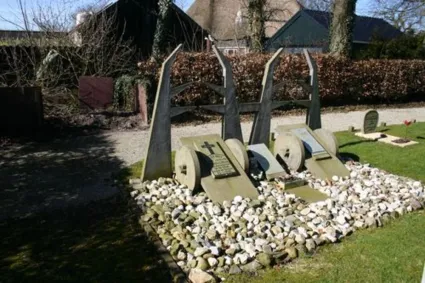
Headmaster Jakob Klok in the resistance
During the war, Jakob (Jaap) Klok ended up in the resistance in Dantumadeel, where he played an important role. At the time, he lived with his wife and four children in Akkerwoude, where he was headmaster of the school at Hearewei 13.
Headmaster Jakob Klok in the resistance
During the war, Jakob (Jaap) Klok ended up in the resistance in Dantumadeel, where he played an important role. At the time, he lived with his wife and four children in Akkerwoude, where he was headmaster of the school at Hearewei 13. He stayed there until 1947 and will always be remembered as "Headmaster Klok."
Jaap Klok was active socially and in politics as a member of the Dutch Social Democratic Labour Party (SDAP). When party meetings were banned by the German occupiers, Jaap imperceptibly became ever more involved in resistance activities. He passed on party information, distributed illegal newspapers, and looked for addresses for people in hiding. Jaap Klok joined the LO, the National Organisation for Aid to people in Hiding, and became the Akkerwoude village commander.
Although people did not know exactly what he did, it was known that he was in the resistance. Despite the fact that his name circulated among NSB members, he decided not to go into hiding, but instead tried to be even more careful and to sleep at home more often than not.
As the war drew to a close, Jaap became very busy. The Dutch government in exile was calling on railway workers to go on strike. The resistance arranged for the hiding. On 15 December 1944, a group of about sixty refugees from Arnhem arrived at his school. Jaap was indirectly involved in the evacuation committee, which was looking for addresses for the unfortunate Arnhem residents.
Shortly thereafter, he was warned at the schoolhouse that during a raid in Murmerwoude, explicit questions were asked about schoolmaster Klok. Jaap did not hesitate a second and quickly left the house. And not a moment too soon, as ten minutes after his departure the Germans were already on his doorstep. From that moment on, Jaap knew that he had to be very careful. He hardly ever slept at home anymore.
From January 1945 onwards, the situation became explosive. After the discovery of weapons on a farm in Aalsum, the Germans became fanatical. They relentlessly hunted down resistance fighters and used any means to make those who were caught talk. The name "Jaap Klok" was also mentioned during these interrogations. Sufficient reason to leave then and there, with his whole family. The children stayed with relatives. He and his wife went into hiding elsewhere.
During the last weeks of the war, Jaap was very busy. Much had to be organised and discussed within the resistance to expel the Germans and prepare for the arrival of the Canadians. Just before Dantumadeel was liberated, the inhabitants were already beside themselves with joy. They raised the flag and took to the streets en masse to celebrate. Because of his resistance work, Jaap knew exactly what the situation was with regard to the liberation. He climbed onto the balcony of the town hall and addressed the people. After all, the danger had not yet passed. Even when that was the case shortly thereafter, he ensured that peace was maintained among the population of Dantumadeel and thus prevented the molestation of a number of NSB members.
After the war, he held many administrative positions in the province of Friesland. In 1984, Jaap Klok died at the age of 91. Fifteen years later, a statue of him was erected in Akkerwoude, which was then called Damwoude, as a tribute.
From the book "De oorlog een gezicht geven" (deel 6) – Dantumadeel in de periode '40 - '45 by Yvonne te Nijenhuis and Reinder H. Postma

Fusillade aan de Woudweg
Op 22 januari 1945 schieten leden van de 'Sipo und SD' twintig mannen dood aan de Woudweg in Dokkum. Het is de grootste fusillade tijdens de Tweede Wereldoorlog in Friesland.
Fusillade aan de Woudweg
De fusillade in Dokkum is de grootste fusillade geweest tijdens de Tweede Wereldoorlog in Friesland. Een bloedig dieptepunt in de steeds hardere strijd tussen de Duitse bezetter en het verzet.
Het gaat om een wraakactie: drie dagen eerder overvalt het verzet bij het dorp De Valom een auto van de Sicherheitsdienst (SD) met daarin een belangrijke gevangene, in de hoop deze te bevrijden. Bij het vuurgevecht dat ontstaat komen een Duitse SD-er en zijn Belgische chauffeur om het leven.
Artur Albrecht, SD-chef in Friesland, is furieus en wil volgens een getuige Dokkum 'van de kaart van Nederland laten verdwijnen'. Zijn meerderen van de SD-Dienststelle in Groningen geven hem hier echter geen toestemming voor. In plaats daarvan worden twintig gevangenen uit gevangenissen in Friesland en Groningen gehaald en meegenomen naar een weiland aan de Woudweg in Dokkum.
De burgemeester van de stad is zelfs van huis gehaald om toe te kijken. De mannen moeten op een rij gaan liggen in de sneeuw. In groepjes van vijf worden ze naar voren geroepen. Dan klinken er schoten. De lichamen van de slachtoffers moeten een etmaal blijven liggen in de sneeuw, als afschrikwekkend voorbeeld voor de bevolking. De slachtoffers zijn Friezen en Groningers. Sommigen zijn actief in het verzet, anderen zijn Todeskandidaten.
Aan de Woudweg in Dokkum herinnert een monument aan het drama. Jaarlijks is er bij dit monument een kranslegging waarbij leerlingen van scholen in Dokkum worden betrokken.
Verschillende leden van het vuurpeloton worden na de oorlog berecht voor hun betrokkenheid bij de fusillade en krijgen de doodstraf. Zo ook Artur Albrecht. Hij wordt op 21 maart 1952 gefusilleerd op de Waalsdorpervlakte. Het is het laatste doodvonnis dat in Nederland wordt voltrokken.
Dokkum op de Dam
Enkele jaren later, op 4 mei 1956, onthult koningin Juliana het Nationaal Monument op de Dam in Amsterdam. Het monument speelt een centrale rol bij de jaarlijkse Nationale Dodenherdenking op 4 mei die ook altijd wordt bijgewoond door het staatshoofd.
In het monument zijn elf urnen opgenomen met daarin ‘in bloed gedrenkte aarde’. Aarde afkomstig van van strijd- en fusilladeplaatsen uit de elf provincies. Later is ook een 12e urn met aarde uit Nederlands-Indië (het huidige Indonesië) toegevoegd.
Voor het vullen van de Friese urn is aarde gehaald uit de omgeving van Kornwerderzand, strijdtoneel in de meidagen van 1940. Ook is aarde gehaald van fusilladeplaatsen, waaronder de Woudweg in Dokkum en Dronrijp waar op 11 april 1945, een paar dagen voor de bevrijding nog dertien mensen zijn gefusilleerd.
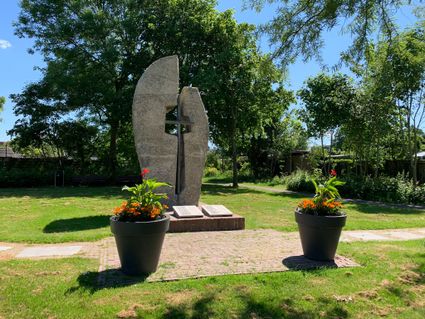
Dokkum (Dokkum)
Dokkum is de meest noordelijk gelegen Elfstedenstad, ze ontstond nadat deze plek een bedevaartsoord werd na de moord op Bonifatius in 754.

End point:
Waypoint walk 63
Dokkum
Navigate to endpoint
Waypoint walk 63
Dokkum
Navigate to endpoint
Directions
Starting point:
Waypoint walk 10
Leeuwarden
Navigate to starting point
The story of the Liberation of Western Europe is a book with many chapters, with some starting before the beginning of the war in 1939 and some others often ending years after the end of the conflict in 1945. Through the Liberation route Europe, you learn more about the storylines, key military events, personal stories and biographies from the second world war in Europe. Check out www.liberationroute.com for more routes, fragments and stories.
End point:
Waypoint walk 63
Dokkum
Navigate to endpoint
- 10
- 09
- 07
- 08
- 08
- 32
- 37
- 30
- 35
- 41
- 36
- 46
- 23
- 59
- 27
- 87
- 52
- 76
- 35
- 28
- 41
- 26
- 54
- 78
- 42
- 22
- 57
- 44
- 32
- 51
- 58
- 62
- 56
- 66
- 63
- 75
- 84
- 62
- 31
- 38
- 63
- 63






